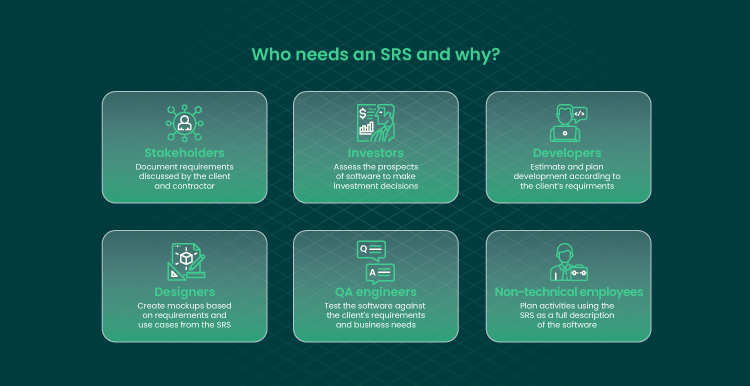Every project owner would tell you that it’s very important to define a product in the early phases of a business. In software development, everyone needs a common understanding of what software is expected to provide. And that is where software requirements specifications come into play. This post will answer the question of why it’s important to define your software requirements before investing in the software development itself.
What Is SRS (Software Requirements Specification) Document?
Software requirements specification is a document that provides a blueprint for the major software system that a business aims to create and implement. This document provides details of the software system at the functional, technical, and commercial levels. This, in turn, introduces the system requirements, operational procedures and strategies, organizational and reference models, standards, and government regulations pertaining to the software. In the end, it contains enough information to guide the software development and deployment in a business.
The idea of creating such documentation is based on the premise that software or systems change frequently and this change can easily lead to technical problems. Take a step back and think of it like building a ship. You have an image of the mast or sail, and you understand how they travel through the waves. However, you need to provide greater specificity to put the ship on the water and keep it from floating away.
The SRS is basically a document that defines what a given software system needs to do and takes care of various requirements. It is written according to the needs of the software and ensures that the software does not cause any problems to the end-users. The different features of the software are clearly detailed and given particular attention. SRS is used to provide certainty, cost, risk, and time planning objectives in software development, including project management, to increase the scope, improve the quality, and lower the cost of a software system.
The document is the unifying standard that the entire team uses. By utilizing SRS, a project can be executed successfully and efficiently.
Who Needs Software Requirements Specification
Today, a common ecommerce trend among owners of small and medium-sized businesses is using SRS to write a business plan for creating software solutions. Regardless of the size of your software project, SRS is a key foundational software project management practice that every team or project needs to follow. It’s your company’s job to build a sustainable software product. You also need to be able to leave a mark on your development team’s lives. That is, to ensure that they can have a stable work environment and follow their long-term goals.

Why Is Software Requirements Specification Document Important?
Writing software requirements is high-stakes and is usually handled by different teams. Whether you’re a project manager, developer, or business analyst, you’ve probably found it difficult to communicate with all parties about the requirements for your project. A close examination of their roles will shed light on a crucial shared job among them and help validate and improve the process.
The best way to ensure that a development team creates software that meets your clients’ needs is to ensure that you have clear requirements for the software. Software requirements and validation must take place at the earliest stages of product development. Before you continue developing a product and release it to the market, it is important to carefully consider your solution’s purpose and features. This will allow you to incorporate future changes and help you avoid wasting time and money on product development.
Basically, the SRS serves as a roadmap for a potential project as it provides a guide for every decision and activity that needs to be taken during the project:
- It lays out the high-level requisites of the software to be built;
- It gives designers a clear idea of the project;
- It provides testers with advice on how to create test cases that meet business needs;
- It serves as a manual for the product users who wish to understand the software they purchased;
- It allows all stakeholders to have a clear vision of the future product and decide on its validation.
Without a well-written spec, a product may be built too quickly and not fully meet the end customer’s needs. Here are several other reasons why an SRS is vital.
Communication Point
The general idea behind software requirements specification is to establish clear communication within the team standing behind its development: team leads, sales, developers, designers, etc. Whether it’s for a new product or a change of focus, it lets you know what a company expects from the contract and what a supplier must do, while leaving room for negotiation.
When specialists explain the details of a project in an SRS document, they are able to facilitate an agreement with clients about what will be expected from the project. If the requirements are altered, a client or a product owner can review and approve them in a timely manner – before they are actually implemented. It is the responsibility of the developers to ensure they fulfill these expectations.
Product Features’ Final Description
The product development process is long, costly, and challenging. These challenges have contributed to the rise of standards for established markets. SRS is one of those standards, and its goal is to make it easier for developers to create high-quality products.
SRS describes the final version of the software that came as a result of theoretical and practical discussions with clients. Product versions may be adapted very often during meetings, calls, user tests, and interviews. Many product managers may be faced with simultaneously working with various product iterations, which can be extremely exhausting. Creating a standard for product requirements eliminates any confusion for both a customer and a product team.
Standard Guide For Product Developers
When you’re creating a new product, it can be very difficult to understand what’s needed, what’s appropriate, and what will work. After launching the new design, you may find out that a client is not happy with its final result, and the product needs to be redone. The resulting mass confusion causes product development teams to feel as if they wasted time or resources investing in design because that is simply not what consumers want or need.
In order to effectively plan and run quality assurance tests, SRS documentation has to serve as a standard. SRS gives designers an understanding of their project from the user perspective. It provides a template for maximizing engagement as well as insights to match the design to the use case. For example, designers might be informed of their project’s use case through a statistics report while getting insights into how well their design will perform.
How to Write Software Requirements Specification Document?
Creating a detailed and well-defined SRS is a crucial step that helps teams write high-quality software. It’s essential because it helps you communicate your project’s direction to stakeholders, establish the level of effort, and identify questions you need to answer before starting.

Creating a detailed, functional SRS is not as easy as it seems, though. Here are some tips on how to do it right.
- Ask the stakeholders to outline what they expect from the product. It might seem difficult, but if you write down the answers on a list, you’ll want to make sure you infuse the product with what your customer needs. Asking stakeholders what they expect from your product before you introduce it is a good idea. This will focus them on the needs they have and the features they want to implement.
- Start with the discovery stage. Identify the problem that your product or service should solve. Then, explore the pain points and opportunities for a solution. This is not a step to be skipped: if your product fails to solve the problem it’s meant to solve, you will have to start over.
- Develop a software requirements specification structure. By understanding the elements, you could create a checklist for your own software requirements specification or troubleshoot a requirements specification that you’re currently working on.
The Components of Software Requirements Specification Structure
Once you are ready to build the SRS structure, consider including the following basic elements:
Introduction
The intro’s goal is to drive the document’s purpose and encourage future action succinctly. It should contain the following items:
- Brief description of the document content;
- The end-users of the spec;
- The concept and vision of the product.
Business Goals
When engaged in a business proposal, it’s important to know whether the goals of both parties are aligned. Set up a list of the product’s goals and document it in the SRS. In addition, this section should include your business’s goals and performance indicators.
Intended Use
In this part, you need to describe the end-user (target audience) of your solution, how and for what they will be utilizing your product, what functions and features they will be able to enjoy, etc. Explain the ways that your product can be implemented in any user role, whether he/she is a founder, a developer, a non-developer, or a customer.
Scope
In what ways can a company create a fully-functional product the client will be satisfied with? It all depends on the scope of work a company is tasked with. Describe what kind of job needs to be done in order to translate an idea into a product.
Definitions and Acronyms
Clarify the terminology you are using. This is necessary to make sure your document can be easily read and understood by both technical and non-technical users.
User Needs
A piece of software appearing to serve everyone is, in fact, serving no one. Every business should identify the group they’re looking to target and deliver a product or service that’s highly demanded by that audience. This will increase the chances of product adoption.
System Features and Requirements
Requirements are vital to the operation of a product. The technical requirements of your software or app should be clearly specified. By focussing on a small number of core features, you help your users come to know how a product can fit into their daily lives and how they can benefit from it.

The basics of an SRS are the product’s functional and non-functional requirements. When defining the requirements that your product will need, be sure to provide the needs of your users and those of the business requirements. That way, you can build the solution with minimal effort and avoid any loopholes.
Functional Requirements
Functional requirements are items, clauses, or features that specify how a system should perform specific, externally visible functions. They can be specified as the features, functions, and properties that a system must contain. Moreover, the system requirements must agree with the functional requirements so that there should be a contract between both the system specifications and operational procedures.
Nonfunctional Requirements
You’ve signed a contract with your software developer, and they’ve delivered the new software with all of the functional features and functionality. Now it’s time for the non-functional requirements of a system, which can be a big part of any project. Non-functional requirements can be used to optimize a product. For instance, they define how a system will implement features like the speed of completion.
Tech Stack
Indicate what tech stack you are using. A stack is an arrangement of different software components working together that are utilized to create a high-quality product swiftly. It is important that you explain what tech stack you chose and outline your reasons.
Overview of Product’s Main Features
Running a business means product research is necessary. During the discovery process, a business often gets caught up in how much money they can potentially spend on a product without thinking about whether that product is good enough. This is a mistake. What’s more important is evaluating the product’s main features and reviewing how the product is going to impact end-users.
Ensure Point-by-Point Agreement with A Client
You need to make sure the client is on the same page as you about your vision and goals. You need to show clients that you understand their needs and know how to create a product they will like. Likewise, the client needs to spell their requirements clearly in order to avoid confusion in the future.
Characteristics of a Good Software Requirements Specification Document
One of the most important aspects of a good SRS is ensuring it has the following characteristics.
Fits Technical and Non-Technical Users
The technical team is not the only end-users of SRS. Before you start putting your specification together, you need to understand what a product entails for technical and non-technical users. Everyone in the company, ranging from accountants and engineers to managers and executives, needs to understand the software requirements and be able to follow them.
So, how can you make your SRS more understandable for both parties?
- avoid overusing technical terms; for each of those, provide a clear explanation;
- place this list of terms in alphabetical order and in bold;
- add an abbreviation section to explain the terms you use and those that may sound vague.
Contains Clear and Accurate Requirements
One of the most important things you need to do while building or planning a software project is to clearly identify the software requirements. Sometimes things get fuzzy in the execution of a project, so the spec is crucial to making sure the project is the best it can be. Developers want to know exactly what they need to build, while clients want to know that they can trust what they’re buying.
An inaccurate SRS can lead to poor website layouts, poor software performance, poor customer experience, and missed revenue opportunities. With a proper SRS, clients can know that they receive the software they want and need.
Excellent Visualization
Another feature of a useful SRS is visualization. Be sure to use charts, diagrams, graphs, etc to better describe all the elements and their connections. There are many programs and apps on the Internet that can help you with this task. You can also work together with your designers to help them visualize your ideas more precisely.
Final Word
Writing clear, concise, and up-to-date software requirements specifications is an important task. Yet, it is also a task that is rarely documented in an organized manner.
You may create software requirements specification documents manually or automatically in value stream mapping tools such as JIRA Software. This can help you write, update, and allocate the necessary documentation more systematically. Doing so can help Dev and Ops teams align more closely, which, in turn, will lead to a smoother and more productive software development process.
Have troubles with your software development? Contact us, and we’ll gladly help you!

Our Engineers
Can Help
Are you ready to discover all benefits of running a business in the digital era?

Our Engineers
Can Help
Are you ready to discover all benefits of running a business in the digital era?







